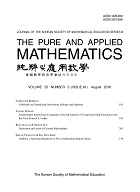2권 2호
초록
Abstract
A Bayes estimator of the survival distribution function due to Susarla and Van Ryzin(1976) is used to estimate the mth moment of a survival time on the basis of censored observations in a random censorship model. Asymptotic normality of the estimator is proved using the functional version of the delta method.
초록
Abstract
Let H be an arbitrary complex Hilbert space and let (equation omitted)(H) be the *-algebra of all bounded linear operators on H. An operator T in (equation omitted)(H) is called normal if T<TEX>$\^$</TEX>*/T = TT<TEX>$\^$</TEX>*/, hyponormal if T<TEX>$\^$</TEX>*/T <TEX>$\geq$</TEX> TT<TEX>$\^$</TEX>*/, and quasi-hyponormal if T<TEX>$\^$</TEX>*/(T<TEX>$\^$</TEX>*/T - TT<TEX>$\^$</TEX>*/)A <TEX>$\geq$</TEX> 0, or equivalently ∥T<TEX>$\^$</TEX>*/T<TEX>$\chi$</TEX>∥ <TEX>$\leq$</TEX> ∥TT<TEX>$\chi$</TEX>∥ for all <TEX>$\chi$</TEX> in H.(omitted)
초록
Abstract
In [6], the author studied the property of the Szeg kernel and had a result that if <TEX>$\Omega$</TEX> is a smoothly bounded domain in C and the Szeg kernel associated with <TEX>$\Omega$</TEX> is rational, then any proper holomorphic map from <TEX>$\Omega$</TEX> to the unit disc U is rational. It leads to the study of the proper rational map of <TEX>$\Omega$</TEX> to U. In this note, first we simplify the proof of the above result and prove an existence theorem of a proper rational map. Before we proceed to state our result, we must recall some preliminary facts.(omitted)
초록
Abstract
In their recent paper[2], they show that the existence theory for the analytic operator-valued Feynman path integral can be extended by making use of recent developments in the theory of Dirichlet forms and Markov process. In this field, there is the necessity of studying certain generalized functionals of the process (of Feynman-Kac type). Their study have been concerned with Feynman-Kac type functionals related with smooth measures associated with the classical Dirichlet form (associated with the Laplacian).(omitted)
초록
Abstract
A C<TEX>$\^$</TEX><TEX>$\infty$</TEX>/ manifold is a pair (M, C) where a) M is a Hausdorff topological space such that every point <TEX>$\chi$</TEX><TEX>$\in$</TEX>M has a neighborhood homeomorphic to an open subset of R<TEX>$^n$</TEX>. b) C is a collection of these homeomorphisms whose domains cover M. If ø, <TEX>$\psi$</TEX> <TEX>$\in$</TEX> C then ø o <TEX>$\psi$</TEX><TEX>$\^$</TEX>-1/ is C<TEX>$\^$</TEX><TEX>$\infty$</TEX>/. c) C is maximal with respect to (b).(omitted)
초록
Abstract
Let A be the class of univalent functions f(z)=z+<TEX>${\alpha}$</TEX><TEX>$_2$</TEX>z<TEX>$^2$</TEX>+<TEX>${\alpha}$</TEX><TEX>$_3$</TEX>z<TEX>$^3$</TEX>+…(1.1) which are analytic in the unit disk <TEX>$\Delta$</TEX>= {z:│z│<1}. Let S*(p) be the subclass of A composing of functions which are starlike of order <TEX>$\rho$</TEX>. A function f(z) belonging to the class A is said to be starlike of order <TEX>$\rho$</TEX> (<TEX>$\rho$</TEX>(equation omitted) 0) if and only if z<TEX>$\^$</TEX>-l/ f(z) (equation omitted) 0 (z<TEX>$\in$</TEX><TEX>$\Delta$</TEX>) and (equation omitted (1.2).(omitted)
초록
Abstract
[1] Show that ∫<TEX>$\_$</TEX>0/<TEX>$\^$</TEX>1/ [∫<TEX>$\_$</TEX>0/<TEX>$\^$</TEX>1/ f(<TEX>$\chi$</TEX>,y)dy] d<TEX>$\chi$</TEX> = ∫<TEX>$\_$</TEX>0/<TEX>$\^$</TEX>1/[∫<TEX>$\_$</TEX>0/<TEX>$\^$</TEX>1/ f(<TEX>$\chi$</TEX>,y)d<TEX>$\chi$</TEX>] Counterexample: If pk denotes the k-th prime number, let S(pk) = (equation omitted), let S = ∪<TEX>$\_$</TEX>k=1/<TEX>$\^$</TEX><TEX>$\infty$</TEX>/ S(pk), and let Q = [0, 1]<TEX>${\times}$</TEX>[0, 1]. Define f on Q as follows; f(<TEX>$\chi$</TEX>, y) = 0 (<TEX>$\chi$</TEX>, y)<TEX>$\in$</TEX>S, f(<TEX>$\chi$</TEX>, y) = 1 (<TEX>$\chi$</TEX>, y)<TEX>$\in$</TEX>Q - S.(omitted)
초록
Abstract
The D-optimal design criterion for precise parameter estimation in nonlinear regression analysis is called the determinant criterion because the determinant of a matrix is to be maximized. In this thesis, we derive the gradient and the Hessian of the determinant criterion, and apply a QR decomposition for their efficient computations. We also propose an approximate form of the Hessian matrix which can be calculated from the first derivative of a model function with respect to the design variables. These equations can be used in a Gauss-Newton type iteration procedure.
초록
Abstract
In this paper we shall consider function p(z) analytic in the open unit circle D and the solutions y(z) of the differential equation y"(Z) + p(z)y(z) = 0. (1.1) The ratio f(z) = u(z)/v(z) of any two independent solutions u(z) and v(z) of (1.1) will be function f(z), meromorphic in D with only simple poles, and such that f'(z) (equation omitted) 0. We shall say that a meromorphic function which satisfies these two condition belongs to the restricted class.(omitted)
초록
Abstract
In stability theory of polysystems two concepts that playa very important role are the limit set and the prolongational limit set. For the above two concepts, A.Bacciotti and N.Kalouptsidis studied their properties in a locally compact metric space [2]. In this paper we investigate their results in c-first countable space which is more a general space than a metric space.(omitted)
초록
Abstract
Let I be the interval, <TEX>$S^1$</TEX> the circle and let X be a compact metric space. And let <TEX>$C^{circ}(X,\;X)$</TEX> denote the set of continuous maps from X into itself. For any f<TEX>$f\in\;C\circ(X,\;X),\;let\;P(f),\;R(f),\;\Gamma(f),\;\Lambda(f)\;and\;\Omega(f)$</TEX> denote the collection of the periodic points, recurrent points, <TEX>${\gamma}-limit{\;}points,{\;}{\omega}-limit$</TEX> points and nonwandering points, respectively.(omitted)
초록
Abstract
G.Lumer [8] introduced the concept of semi-product space. H.M.El-Hamouly [7] introduced the concept of fuzzy inner product spaces. In this paper, we defined fuzzy semi-inner-product space and investigated some properties of fuzzy semi product space.
초록
Abstract
Our objective is to investigate approximate controllability of a class of partial integrodifferential systems. This work continuous the investigations of [8]. As a model for this class one may take the equation <TEX>$\frac{\partialy(t,\;\xi)}{\partialt}\;=\;\frac{\partial}{\partial\xi}(a(t,\;\xi\frac{\partialy(t,\;\xi)}{\partial\xi})\;+\;F(t,\;y(t\;-\;r,\;\xi),\;{{\int_0}^t}\;k(t,\;s,\;y(s\;-\;r,\;\xi))ds)\;+\;b(\xi)u(t),\;0\;\leq\;\xi\;\leq\;1,\;\leq\;t\;\leq\;T$</TEX> with initial-boundary conditions y(t,\;0)\;=\;y(t,\;1)\;=\;0,\;0\;\leq\;t\;\leq\;T,\;y(t,\;\xi)\;=\;\phi(t,\;\xi),\;0\;\leq\;1,\;-r\;\leq\;t\;\leq\;0$</TEX>.(omitted)

